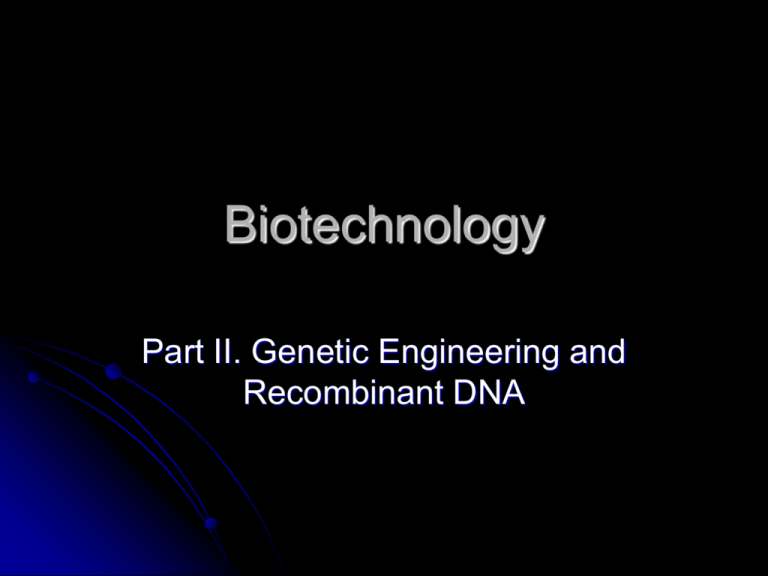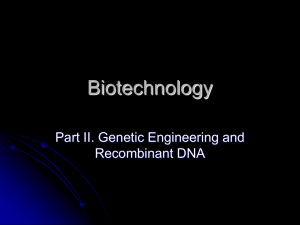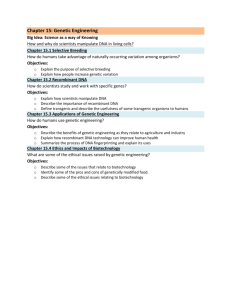Biotechnology
advertisement

Biotechnology Part II. Genetic Engineering and Recombinant DNA Cloned Cats Content Standards 5a.Students know the general structures and functions of DNA, RNA, and protein. BI5. c. Students know how genetic engineering (biotechnology) is used to produce novel biomedical and agricultural products. 5e.* Students know how exogenous DNA can be inserted into bacterial cells to alter their genetic makeup and support expression of new protein products. Objectives: SWBAT explain the structure and function of DNA, RNA, and proteins. predict the physical characteristics of an organism based on its genetic make up. understand the general pathway by which ribosomes make proteins. understand how altering an organisms genetic make-up changes the proteins the organism produces. Genetics Review Genes code for proteins (transcription and translation) Proteins-make-up physical characteristics Changes in the DNA sequence will affect the genetic code (mutations) If the genetic code is changed then a protein can be changed This can change an organisms’ physical characteristics How is Biotechnology a part of your life? Medical research Consumer products (clothing) Forensic Science (crime scene investigation) Maury (paternity tests) Genetically modified foods (you eat them on a daily basis) What is Biotechnology? Bio=life Technology=usage and knowledge of tools and crafts Biotechnology- technology that uses biological systems, living organisms, or products made from living organisms to make or modify products or processes for specific use What is genetic engineering? Altering genes to produce a protein Changing of an organism’s DNA to give the organism new traits Transgenic organisms-has one or more genes from another organism inserted into its genome Uses-medication and genetically modified crops What are plasmids and restriction enzymes? Bacterial Plasmids-circular pieces of DNA, found in bacteria Restriction enzymes-enzymes that cut DNA at specific sites Restriction sites-sections of DNA recognized by restriction enzymes as the place to “cut” the DNA (BamH I, Hind III ) How are recombinant DNA molecules produced? Recombinant DNA-DNA sequence that is produced from combining DNA sequences, contains more than one organisms genes RE-used to cut out desired gene from DNA Plasmids are cut with same RE Plasmid opens and gene is added to plasmid Sticky ends of DNA are bonded together (ligation) Recombinant E.coli plasmid Discosoma sp (sea anemone) E.coli restriction analysis of pKAN-R and pARA pKAN-R 5408 bp rfp 702 bp pARA 4058 bp 40 bp ligation of pKAN-R/pARA restriction fragments BamH I sticky end Hind III sticky end Hind III sticky end BamH I sticky end Summary Questions What are some beneficial uses of transgenic organisms? How are recombinant DNA molecules produced? (describe this process in detail)








